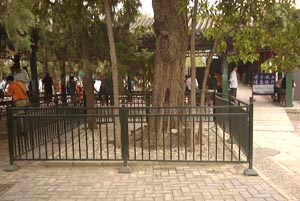Home > Site analysis > Choosing desirable tree attributes > Longevity
Longevity
Large-maturing trees often live longer than small trees. It would appear that large, long-lived trees might be the logical choice for planting in most landscape situations since they would provide for a lasting effect. However, with reasonable placement and care, long-lived trees will probably outlast many of today's streets, homes and buildings.
Many structures are renovated or expanded 30 to 50 years after construction. The renovation is often so extensive that it becomes difficult to provide the needed protection for the extensive root system to keep the tree alive. For this reason, concern about tree longevity may be inappropriate in highly urbanized landscapes unless special provisions are undertaken to protect the tree.
 Life span is of least concern in the most stressful urban sites. Trees in parking
lots islands, small non-engineered sidewalk cutouts and those growing in other
small soil spaces have short lives almost regardless of species.
Life span is of least concern in the most stressful urban sites. Trees in parking
lots islands, small non-engineered sidewalk cutouts and those growing in other
small soil spaces have short lives almost regardless of species.
Life span may be an important tree selection criteria in large open areas such as in parks and on residential or some commercial landscapes where little disturbance is expected beneath the tree and there is plenty of soil space for root expansion. At these sites, long lived trees may be a better investment than those with a shorter life because they will have to be replaced less often.

